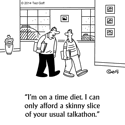Looking ahead to 2009
Like lots of others, I enter 2009 with a bit of anxiety. I have less visibility into the market for my consulting services than I have had in nearly two years.
Yet I have never been as optimistic regarding the soundness & value of the work I'm doing.
Hopefully it's not self-delusion. I don't believe it is.
Yet as I've reflected over what I've done & learned in 2008, I'm more convinced than ever that the time is ripe for what I'm doing.
Which is: working with companies to gather, sort, make sense of their customers' freeform feedback. Using, as it were, these story fragments unlocks a rich store of information unbiased by survey hypotheses and distinguished by candor.
It's a great time, too, to be working in this area. Social tools, especially Twitter, are a new and easily-searched archive of customer emotion.
In the recent Futurelab live blog session, the question was rightly asked about why I'd be interested in peering into people's minds and emotions--isn't what they do more important than what they think?
I didn't answer that question very well that day, but having had time to think about it, I'd say this: I'm not trying to read minds. I'm trying to hear what people say. People talk or write when something happens that is significant to them. If they're using a company's product and say something that's significant to them, it's significant to that company too.
One reason companies don't listen to these stories that they are loud & cacophonous and loaded with noise. They can be rude & inconsiderate. They are in the customer's language & context, not the company's.
But using sensemaking techniques informed by cognitive science & the study of complex adaptive systems (Kurtz & Snowden), the resonances, themes & values in the mass of stories can be found.
And companies can use these resonances to see where their products are generating delight and where they're creating frustration. Where their customer service is working & where it's breaking down. And why some people who call to order a product don't end up doing so, in spite of the company's best efforts. .
The current downturn will shake out companies who hate their customers, who prey on them, who profit through punitive and well-hidden fees & surcharges.
The ones that are left will value every single customer, will treat them respectfully & will really want to understand what those customers want & how they feel.
The approaches I'm working with are a vital tool in this quest. And that's why I'm optimistic for 2009, regardless of what I read in the paper.
Happy New Year!
















